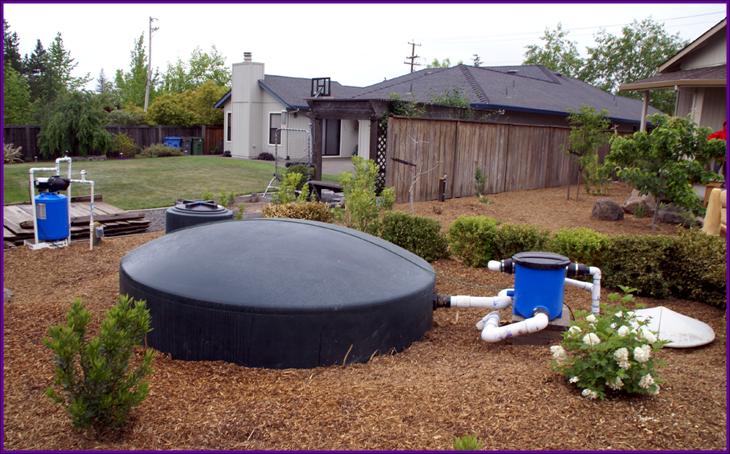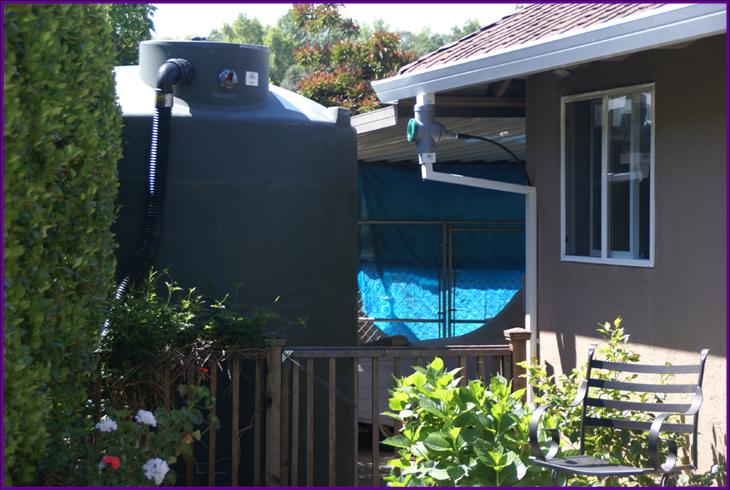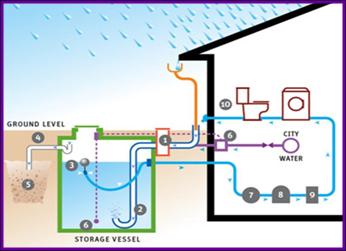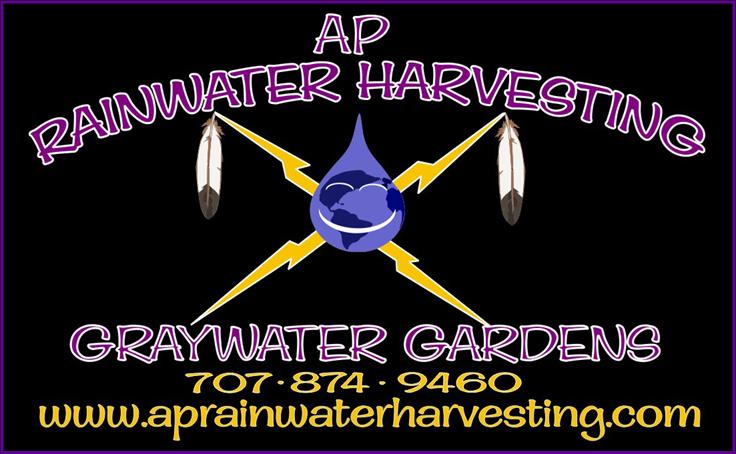
|
RAINWATER ROOF COLLECTION BASICS The process of storing harvested rainwater is pretty simple. Rainwater flows from the roof to the gutters into a downspout. From the downspout, you can either employ a first flush system or simply install a downspout filter or downspout diverter. If living in a rural setting with a non-asphalt roof, a first flush system may not be necessary if the end use is just for irrigation purposes. However, for highest quality water, a first flush system is recommended as it removes both roof debris and contaminants. Both downspout filters and diverters separate out debris and contaminants. A downspout diverter sends the cleaned water to the storage device (tank) while dirt and debris are washed down the water pipe with a small amount of rainwater 1. Rainwater flows from the roof to the gutters into a downspout. One inch of rain on a 2000 square foot house produces more than 1200 gallons of rainwater. 2. Install a first flush system or a downspout filter or diverter to separate out debris and contaminants or a volume filter before the storage tank to filter several downspouts. 3. Pipe the filtered rainwater into a storage unit using either gravity or a pump (solar or electric) to achieve the necessary force for the water to flow freely into and out of unit. 4. Store the filtered rainwater in the tank or pond. A calming inlet aerates the water while preventing incoming water from disturbing sediment on the bottom of the tank. A floating inlet hose can in the middle of the tank provides access to the cleanest water. 5. An anti-siphon overflow device is adapted to the tank to redirect overflow water, act as a backflow device, and keep out thirsty rodents and mosquitoes. 6. Your additional water source can be used to irrigate vegetable gardens. flowers, trees, lawns, or be dual plumbed back into the house to flush toilets or wash clothes.
STORAGE UNITS The key to rainwater catchment lies in the storage of the harvested water. Your choice of storage units depends on a variety of factors including your space availability, end-use needs, and aesthetics. Storage tanks are composed of various materials including: ¨ Polyethylene tanks are probably the most widely used tank. They come in a multitude of sizes and offer potable and non-potable tanks for water storage. ¨ Metal tanks, easily the top-shelf tanks of choice, are primarily manufactured of stainless steel and corrugated galvanized steel tanks and are very cost-effective for large storage. ¨ Wood tanks are the top-of-the-line option for water enthusiasts. Locally made redwood and oak tanks are easily worth the extra investment. ¨ Pillow tanks are excellent for fitting under the crawl space or deck in residences with limited space availability. ¨ Below ground cisterns are another alternative using galvanized steel, or polyethylene to offer versatility and innovative below ground storage capacity. ¨ Man-made ponds are an inexpensive alternative for storing water, but there is the issue of evaporation that must be dealt with as well as debris entering the pond.
GETTING STARTED To get started, you need to answer the following questions… 1. What materials make up the roof of your house or structure? 2. What is the end use of the stored rainwater? 3. How much water do you need? How much do you want to store? How do you envision storing it? 4. What is the lowest carbon footprint approach to rainwater harvesting?
What materials make up the roof of your house or structure? Many of us have composite or asphalt roofs and rainwater runoff from this kind of roof needs to be filtered out to protect your garden’s environmental integrity. Weather Barrier Rain Coat 2000 is an acrylic roof coating that can be applied over an existing roof of less-desirable materials such as asphalt shingles. Due to its light color it is also effective in passively cooling buildings. A metal or tile roof is a much cleaner material and downspout filters work fine to remove debris. What is the end use of the stored rainwater? Determining your end use for the water is vital for choosing the right filtration system. How much water do you need? How much do you want to store? How do you envision storing it? There are a variety of issues that need to be considered when deciding how much water you “need.” Obviously how much you need will significantly influence how much you intend to harvest and store. To assess your how much water you use, surf the net to one of the sites below to find a water calculators to assess your “water footprint.” The One Minute Water Calculator (http://calc.zerofootprint.net/one_minute/unilever/countries) Institute of Water Education (http://www.waterfootprint.org/?page=files/WaterFootprintCalculator) To figure out how much rainwater you conceivably have available, you need to approximate the amount by looking up the average number of inches of annual rainfall in your area and then multiplying it by 620 gallons per 1000 sq ft of roof. From there, choosing the right storage device depends on space availability, landscape topography, finances, and aesthetics. What is the lowest carbon footprint approach to rainwater harvesting? As much as possible, make it a gravity-fed system. The second-choice is to utilize solar pumps and the last is pump to end-use.
HOW MUCH DOES A SYSTEM COST? The answer to this question is subjective at best. Everything depends on your short- and long-term vision, the complexity simplicity of the property, as well as the local climate. Designing the right kind of system for you requires striking the right balance between a handful of important ecological considerations. A rainwater harvesting system can be as small as a few rain barrels connected to homeowners' downspouts for landscape irrigation to as large as expansive tanks for home uses such as laundry washing and flushing toilets to huge tanks for refilling swimming pools and fire abatement. Each rainwater system must be custom-designed to meet the specifications required by law and your own needs. That said, a rainwater harvesting system can range from a couple thousand dollars to double digits and beyond, but the rewards are many.
ENVIRONMENTAL BENEFITS The seemingly simple task of collecting rainwater can prevent considerable amounts of sediment and pollutants from entering local waterways. Non-point source pollution that results from storm water runoff often contains pesticides and fertilizers from local landscapes, oils from roads and driveways, as well as eroded sediment and agricultural waste. Upon the installation of rainwater harvesting systems at the downspouts of buildings, water is intentionally contained and thereby prevented from running over landscapes and impervious surfaces, or contributing to storm water damage. Recent studies have shown that pollutants in storm water runoff are the number one cause of pollution in rivers, streams, lakes, and wetlands. You can slow this process by harvesting your rainwater and implementing rainwater retention techniques and technologies.
IN CONCLUSION… People the world over are being forced to wake up to the challenges posed by water scarcity. Hence, issues such as rainwater harvesting, soakaways, higher water costs, changing groundwater levels and storm water balancing concern each of us. Meeting these different rainwater issues requires the installation of innovative, integrated rainwater/graywater recycling systems. Once you have harvested and stored your rainwater, you can use it to flush toilets, do laundry, wash your car, and water your garden and lawn. If a potable filter is employed, then you can also use it to shower in, cook with and drink. The possibilities are endless! |
|
HOW RAINWATER HARVESTING WORKS |
|
“Yes, government must lead on energy independence, but each of us must do our part to make our homes and businesses more efficient. Individual responsibility and mutual responsibility—that's the essence of America's promise.”
|

|
This diagram above displays a basic rainwater harvesting system. It starts with rainwater flowing from the roof to the gutters into a downspout filter, which initially filters the rainwater separating out debris and contaminants. If a first flush diverter is used, it sends the first few gallons into a drainage system. The rest is captured and flows into a storage tank which can range from a few hundred to thousands of gallons. Inside the tank, a smoothing (or calming) inlet aerates the water while preventing incoming water from disturbing sediment on the bottom of the rainwater tank. A floating inlet hose floats in the middle of the tank to |
|
Water is the life blood of our planet. All life thirstily craves water to survive. But while we may be obsessed with oil, we are not an oil-based culture; we are a water-based one. Humans are, in fact, made up of 70% water and so is the Earth. But 97% of the earth’s water is salt or stagnant. Of the 3% left, 2% is locked up in glaciers and the polar ice caps. This leaves 1% available for all our needs. Given these facts, it is surprising how little attention is paid to water scarcity issues in the 21st century. The CA Water Board’s recent decision to call for a state-wide 20% reduction of water availability to the people, businesses and farms of California is really just the tip of the (melting) iceberg. Isn’t it time you made sure you have water for your family or business no matter what? |
|
Rainwater Harvesting Techniques |

|
Rainwater Filters |
|
Rainwater Products |
|
Storage Tanks |
|
Graywater Products |
|
Ap Rainwater Harvesting & Graywater GARDEns |
|
Providing Innovative Green Solutions For All Your Water Needs |



